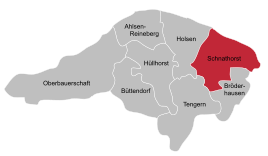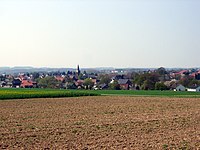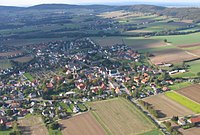Schnathorst
|
Schnathorst
municipality Hüllhorst
Coordinates: 52 ° 16 ′ 31 ″ N , 8 ° 42 ′ 37 ″ E
|
|
|---|---|
| Height : | 115 m above sea level NHN |
| Area : | 5.62 km² |
| Residents : | 2702 (Dec. 31, 2018) |
| Population density : | 481 inhabitants / km² |
| Incorporation : | 1st January 1973 |
| Postal code : | 32609 |
| Area code : | 05744 |
|
Location of Schnathorst in Hüllhorst
|
|
Schnathorst is a village on the southern slope of the Wiehengebirge with around 2700 inhabitants. As part of the municipal reorganization of North Rhine-Westphalia in 1973, it became a part of the municipality of Hüllhorst in the Minden-Lübbecke district .
geography
Spatial location
Schnathorst is located on the southern slope of the Wiehengebirge, whose ridge represents the northern limit, in the Ravensberger hill country . It is 25 kilometers to the middle center of Minden and 35 kilometers to the closest regional center of Bielefeld .
The highest point is the Schnathorster mountain at 247 m above sea level. NHN , the deepest valley is on the Schnathorster Bach on the border with Tengern and is 70 m above sea level. NHN . The church is 115 m above sea level. NHN .
The Struckhof district also belongs to Schnathorst .
Neighborhoods
Schnathorst borders the following localities, communities and cities (clockwise, starting in the north):
Nettelstedt ( town of Lübbecke ), Oberlübbe ( town of Hille ), Wulferdingsen ( town of Bad Oeynhausen ), Bröderhausen , Tengern and Holsen (town of Hüllhorst).
history
Meaning of the place name
The name of the place is made up of the parts Schnat and Horst.
- Schnat = Low German = border.
Not in the form of a line, but a natural border. Here a more or less wide strip of forest or wasteland (see also: Schnatgang ).
- Horst = wooded hill, in this case probably the ridge of the Wiehengebirge (compare also: Horst ).
Loosely translated, Schnathorst means "border forest", whereby the different interpretations should be kept in mind.
First documented mention in 1244
In 1244, the enfeoffment of a hoof in the Lippe district of Schötmar is attested in a document by Richardus de Snathorst, among others. This had the social rank of a ministry and owned on loan from Amte Snathorst, after whose name he was named. Information on the place and structure of the place are not communicated, but from the position of Richardus it can be deduced that it was probably a Meierhof to which further hooves were assigned (see also Villication ).
Late Middle Ages 1300–1500
In 1330 the office of Schnathorst came into the possession of the nobleman Johann von Lübbecke as an episcopal fief and was pledged by the bishop to the von Grapendorf brothers in 1464. They sold it to the cathedral chapter in 1490. From the time around 1550 there is a list of the duties to the chapter from which the conditions at that time can be read very clearly.
The Urbar 1600
In 1645/1646, at the end of the Thirty Years' War , the Principality of Minden is under Swedish occupation. Since the Swedes believe that they will be able to keep the principality even after a peace agreement, they begin at this time to create a basis for the future administration and raise the land registry of the Reineberg office. This "court census" is the first complete list of the place Schnathorst. The name, size and type of the farm, dependencies and taxes to be paid, as well as the cultivated arable land are listed in detail. There are 28 farms on which around 160 people live. A special feature is that 16 of the courtyards belong to the cathedral chapter and only four to the sovereign (Amt Reineberg). The other sites are assigned to the parish church.
The French occupation in 1800
In 1807 the office of Schnathorst is dissolved and integrated into the newly founded canton of Reineberg based on the French model. In the following years Schnathorst belonged to the Kingdom of Westphalia and from 1810 even directly to the French Empire. With the end of French rule and the subsequent reorganization, Schnathorst was assigned to the Bünde district in 1816. After its dissolution in 1832, the place comes to the newly created district of Lübbecke and within it to the Hüllhorst office.
In 1843, with the implementation of the Prussian rural community order, the Schnathorst office was created. It now includes the communities Schnathorst, Tengern, Holsen, Bröderhausen, Hüllhorst, Ahlsen-Reineberg, Büttendorf and Oberbauernschaft. At that time the office had 4940 inhabitants, 654 of them in the municipality of Schnathorst.
As early as 1856, with the coming into force of the community order, this condition was dissolved again and Schnathorst became an independent community in the Hüllhorst district. The newly introduced municipal self-government entitles every independent citizen to participate in public business. There was an elected council and a councilor . This order existed (with some changes) until 1933.
Early 1900
National Socialism and the Second World War
With the law for the alignment of the states with the Reich, all municipal offices and municipal councils are dissolved. Heinrich Hagemann becomes community leader (community school). There are 1148 inhabitants counted.
The post-war period 1945–1990
After the end of the war, Wilhelm Huchzermeier, who was in office from 1921 to 1933, was appointed mayor of the British military government. In the first local elections in 1948 he was confirmed in office for a further four years until 1952 due to a tie in the local parliament.
From 1952 to 1972 Hermann Bode then directed the fortunes of the community, which by then had grown to 1,723 people.
From 1953 to 1972 Schnathorst had its own glider flying area , which was closed due to legal regulations. The associated hangar on the "Am Berge" street is still standing today.
On April 6, 1970, the nine municipalities of the Hüllhorst office vote for the formation of a large municipality. With a further resolution of August 30, 1971, the new municipality was named Hüllhorst on January 1, 1973.
The year 1994 was the occasion and time of a well-attended 750th anniversary celebration in the village center.
Population development
|
Source:
Economic development
The main source of income for the population of Schnathorst has always been agriculture . Most of the livestock was kept for personal use, there was almost no forest management. Grown wheat , oats , peas and beets , and later potatoes . However, since there was a lack of suitable cultivation methods ( crop rotation , 4-field farming) and fertilizer, the yields were often poor.
Up to the middle of the 19th century, a large part of the population also lived from growing flax and processing it into linen by spinning and weaving at home. It was this physically hard work that ensured a tolerable livelihood for many of the residents together with agriculture. With the advent of mechanical yarn production and processing ( Ravensberger Spinnerei ) and the importation of cheap alternative products such as cotton , manual processing was no longer competitive practically overnight. Due to the poor transport connections, industrial production could not establish itself in this area.
There were few alternative jobs at that time, the population was becoming increasingly impoverished, and poor harvests did the rest. Many residents took this as an opportunity and emigrated to America or the Prussian province of Posen .
At the end of the 19th century, the emerging cigar production offered an excellent main or sideline source of income . This work could again be carried out at home and was relatively easy to learn. Soon afterwards, the first cigar factories (branches of the large Bünder manufacturers) were also established in Schnathorst.
Emerging from suppliers to the cigar industry, woodworking and mechanical engineering companies slowly established themselves . In addition, the clay industry developed and created jobs.
The ban on wrapping machines in cigar production meant that this branch of industry was able to hold up into the 1950s, but falling demand due to the success of the cigarette then led to a rapid decline.
Today agriculture only plays a subordinate role.
politics
Results of the local elections on August 30, 2009. Turnout 57.8% (source: KRZ):
| Political party | be right | percent |
| CDU | 574 | 47.48 |
| SPD | 439 | 36.31 |
| Green | 107 | 8.85 |
| FDP | 89 | 7.36 |
| total | 1230 | 100 |
Culture and sights
Buildings
- Old Watermann brickworks Struckhof 1891–1914. Only the remains of the machine house and the factory owner's house can be seen. Furthermore, the clay mining areas (Kuhlen) in the vicinity can still be made out very well. There was also a stop for the Wallückebahn (1897–1937) here, as can be seen in the old station building and the street "Am Bahnhof" in Schnathorst.
- Evangelical Church from 1901/02. The old church was only supposed to be renovated and rebuilt at the beginning of the 20th century. It turned out that it was extremely dilapidated. The then incumbent pastor practically single-handedly decided to build a new church. The Schnathorster Church is the largest village church in the old Lübbecke district.
- Fire station in Lübber Siek from 1914 with a riser and drying tower and a detention cell.
- Historic center with restored half-timbered houses
- Dutch windmill Struckhof
Monuments
The war memorial north of the church bears the names of the fallen soldiers of the First World War from Bröderhausen, Holsen, Huchzen, Schnathorst and Tengern.
Museums
Schnathorst Toy Museum: On 250 m², the museum, which opened in 1997, shows around 500 dolls, dollhouses and accessories, as well as over 1200 cars, tin toys , steam engines and trains, picture books and games from the period 1830 to 1975.
Many pictures and further information about Schnathorst can also be found in the Hüllhorst local history museum .
music
Since 1894 the Schnathorst trombone choir has shaped church life in particular, along with the Tengern trombone choir, which was founded in 1909. In 1958 the Schnathorster Blasorchester was founded, which celebrates success in regional and international appearances on radio and television. The choir community "Am Wiehen" mainly makes choral music without instruments.
Nature and leisure
On the wooded ridge of the Wiehengebirge in the north, the Wittekindsweg invites you to hike, which extends over 95 kilometers from Porta Westfalica in the east to Osnabrück in the west.
Schnathorst and its Struckhof windmill are connected to the Mühlenroute cycle path .
religion
The Schnathorster area has been shaped by Christianity since the Christianization , today mainly by the Evangelical Lutheran parish. The parish is divided into two parishes, parish 1 with Holsen and Schnathorst and parish 2 with Tengern, Bröderhausen and Huchzen.
Due to immigration after the Second World War , Muslims, Catholics and followers of other Christian denominations now also live in Schnathorst.
Sports
Sports facilities
- DFB mini playing field, at the train station
- Teaching pool at the primary school
- Sports field, at the train station
- Tennenplatz , at the train station
- 2 tennis courts Schnathorster Holz
- Gym at the elementary school
sports
Football is played in Schnathorst organized in the football department of the sports club Schnathorst 1925 e. V. (short: SV Schnathorst or SVS). Handball is played at the HSG Hüllhorst, the syndicate is an amalgamation of the handball departments of SV Oberbauerschaft and SV Schnathorst. With the mill pilots of SV Schnathorst paragliding is practiced at the windmill Struckhof and can also be experienced by laypeople as a tandem flight. Since 1948 chess has been played on Tuesdays at the "Springer" chess club in the Rührup restaurant.
Others: swimming, sport shooting, tennis, gymnastics
Events
Regular events
The windmill Struckhof is open with its mill opening days from April to September as part of the Westphalian Mill Road. In flying weather you can also watch paragliders and hang gliders taking off from the winch and then gliding. Tandem flights are possible.
On the eve of the Day of German Unity, the community tree will then be brought up again as part of the autumn TREFF and Oktoberfest of the association community.
In October the SC "Springer" organizes the "Autumn Open" ( rapid chess tournament ) in the village community center.
In the second week of December, the well-attended Christmas market on Saturday at the school has established itself in the village culture.
Venues
- Village community center, at the train station
- Parish hall of the Evangelical Lutheran parish
- Struckhof windmill
societies
There are many clubs in Schnathorst,
Economy and Infrastructure
Due to its development, Schnathorst unites different branches of the economy, whereby its economic situation is not linked to that of the individual branches. There are various service industries, the furniture industry, mechanical engineering, companies in the wood and metal processing industry, the construction industry and the IT industry.
Established businesses
- Wortmann AG (441 employees, IT company)
education
Schnathorst has a primary school, which was expanded to include a gym and a teaching pool in 1960, as well as a Protestant kindergarten. Both public facilities are shared with children from the neighboring village of Holsen. Secondary schools are located in Hüllhorst , Bad Oeynhausen , Minden , Lübbecke and Löhne .
traffic
Streets
The place is crossed by two state roads and a county road. The L 876 leads from Rothenuffeln in an east-west direction to Hüllhorst , the L 803 from Nettelstedt in a north-south direction to Tengern. The K 27 runs from Ahlsen in a west-east direction to Dehme .
Bus transport
Furthermore, Schnathorst is connected to the local public transport in the directions of Bad Oeynhausen , Löhne and Lübbecke by bus lines from BVO Busverkehr Ostwestfalen GmbH .
water
The water supply is organized by the waterworks of the municipality of Hüllhorst, the water is pumped from the glacial valley of the Weser in the district of Südhemmern in the municipality of Hille . The wastewater is disposed of by the Tengern sewage treatment plant .
Personalities
- Johann Heinrich Volkening (1796–1877), Protestant pastor in Schnathorst from 1822 to 1827, an important representative of the revival movement
- Hermann Struckmeier (1920–2009), district administrator from 1969 to 1984
- Siegbert Wortmann (* 1955), computer pioneer, entrepreneur
- Lieselore Curländer (* 1956), local politician and district administrator from 2003 to 2009
literature
- Parish Schnathorst (Ed.) Since 1425 - Parish Schnathorst. Hüllhorst 1980
- Church community Schnathorst (Ed.) Interior decoration of the church in Schnathorst. Schnathorst 1912
- Vereingemeinschaft Schnathorst (ed.): Wir Schnathorster: Looking back over 750 years; Contributions to local history 1244–1994. Publishing house Uhle & Kleimann, Lübbecke 1994
- Werner Abelshauser (ed.): The slightly different industrialization. Studies on the economic history of the Minden-Lübbecker Land in the 19th and 20th centuries. Klartext-Verlag, Essen 1999
- Rolf Momburg, Hans E Brandhorst (Ed.): Brickworks everywhere: The development of the brickworks in the Minden-Lübbecker Land and in the neighboring neighborhood. Minden History Association V. 2000
- Rolf Momburg: weirdo - weaver - clothes maker. Publishing house Kurt u. Margarete Meyer Hüllhorst, ISBN 3-920621-07-7
- Rolf Momburg: The cigar makers. Publishing house Kurt u. Margarete Meyer, Hüllhorst ISBN 3-920621-06-9
- Bernhard Uhle: The Wallückebahn. Uhle & Kleimann Verlag, Lübbecke 1987, ISBN 3-922657-62-1
- Gerhard Stalling AG (Ed.): The Lübbecke district , Publishing Group Municipal Policy + Economy, Oldenburg 1972
Individual evidence
- ^ Federal Statistical Office (ed.): Historical municipality directory for the Federal Republic of Germany. Name, border and key number changes in municipalities, counties and administrative districts from May 27, 1970 to December 31, 1982 . W. Kohlhammer, Stuttgart / Mainz 1983, ISBN 3-17-003263-1 , p. 324 f .
- ↑ Numbers & Dates. In: Website of the municipality of Hüllhorst. Hüllhorst community, accessed on April 7, 2019 .
- ↑ Homepage Schnathorster Blasorchester: About us , accessed on February 12, 2018.










